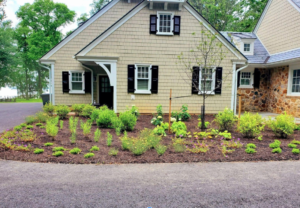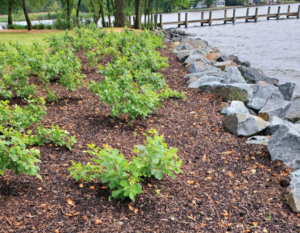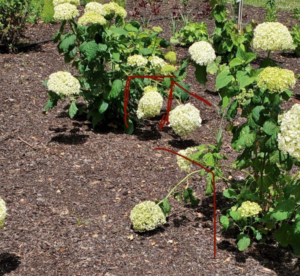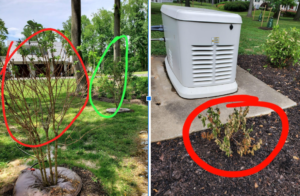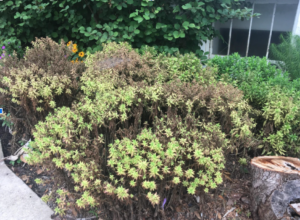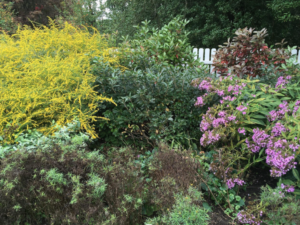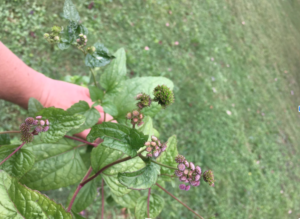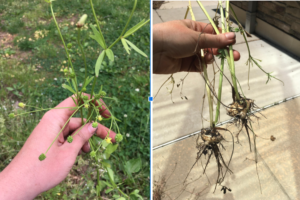A Season in Review
By Kelsey Skaroff
2020 was obviously a remarkable year for many in adjusting work, relationships, and life in general in response to a pandemic, social justice movements, the economy, climate change, and politics. Aside from a brief moment of uncertainty and new protocols, my role as Head Gardener at GreenWeaver Landscapes in greater Philiapdephia is still very close to what it was before.
When I think about what I do, one of the most prominent feelings to emerge is that of gratitude, and especially so in light of this past year. Gardening ecologically connects us with the natural world in a way that many of us have forgotten. It is surprisingly intuitive and helps us to better understand relationships of all kinds. To be constantly learning about better practices to take care of our earth and ourselves is a timeless gift. Knowing this urges me to stop what I’m doing and exclaim, “I love gardening!” (Just ask my crew: I did so several times this year.)
Mirna Managing New Plantings in North East, MD
One of the main challenges of working under COVID-19 shutdowns was being more flexible with our scheduling for both employees and clients. In one instance, this led to one of my gardeners, Mirna, to solo manage a property two days a week at a Chesapeake Bay tributary. This property has extensive foundation plantings, tree installs, coastal plantings, and rain gardens. The maintenance required weed control, perennial healthcare, watering, IPM focused on deer damage and certain insects, and protecting new plant warranties. Some hurdles she ran into were nutsedge management, wind damage, and a bit of tidal erosion, but all were easily managed with close monitoring and implemented routines. The property is in great shape and we are excited for year two.
- Extensive foundation plantings: native perennials (pollinator plants including asters, rudbeckia fulgidia,Asclepias tuberosa, Lobelia cardinalis . Photo by Mirna Canales. Early summer. Northeast, MD.
- Shore stabilizing plantings.Photo by Mirna Canales. Early summer. Northeast, MD.
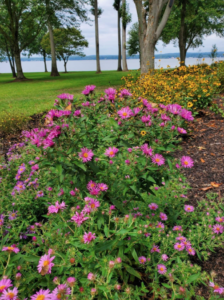
Aster novi-belgii( New York aster) and Rudbeckia hirta(black-eyed Susan) brighten the view toward the water. Photo by Mirna Canales. Midsummer. Northeast, MD.
Communication about the maintenance required a bit of creative problem solving as I was assisting remotely. For the more abstract aspects of horticulture and ecology, this was a challenge at first. It didn’t take long, however, for her to regularly send photos and videos, often with her physically touching plants and narrating, to give a more tactile experience of the work she was doing and the space she was navigating. It provided a lot of clarity. I would sometimes mark up a photo she sent me and send it back along with some written input.
- Photo by Mirna Canales. Markup by me, indicating where to prune the hydrangeas. Early summer. Northeast, MD.
- Photos sent and marked up by Mirna Canales, showing potential plant failures. These were often accompanied by videos of her touching the plants and their leaves, allowing me to hear and see their condition; checking bark to see if it was alive or dead; etc. I would then advise her to prune, fertilize, or cut down plants completely. Early summer. Northeast, MD.
Something I appreciated a lot was Mirna sending more casual photos and videos showcasing the awesome wildlife in that region. Some memorable ones showed turtle eggs, a washed-up wolf fish, hawks, and bald eagles, often with Mirna’s commentary in the background, which was usually affectionate or humorous.
Some Thoughts and Feelings of Working During COVID-19
Smelling and feeling plants and the air and the weather are all super informative sensory experiences while gardening. They are learning tools I rarely took for granted, and since wearing a mask, I miss having access to that by default. It’s been an adjustment. I would also like to acknowledge that driving separate vehicles to slow the spread of COVID releases more carbon emissions and puts more wear and tear on cars, both of which are not good for the environment and thus ourselves.
Of course, learning to work under these guidelines is new to us, and I am sure as we continue to function through a pandemic, we will learn new information and figure out new ways of navigating. I just want to bring to light these observations in order to spark a conversation or think about new ways of doing things. Something different about this year that was often a pleasure was more clients being home during our visits. In many cases, our clients took the opportunity to garden with us. This was an awesome way to know each other better, and for them to understand what was happening in their garden and how we took care of their garden.
Climate Change: Mild Winter, and (Always) a Hotter and Wetter Summer
With the exception of maybe three extremely brisk days, winter 2019-2020 was very mild. It was not uncommon for temperatures some days to be as high as the mid to upper 40’s, and I remember there being quite a bit of rain, but no snow. While this reality was unsurprising it was still a bit disappointing: I love to experience a few good heavy snowstorms in the winter so I can indulge in coziness as well as the visual interest snow adds to the landscape. Most importantly, however, the freezing temperatures that activate winter dormancy are a crucial part of seasonal changes, and something the local ecology has largely evolved with and depends on. Many fruiting plants, bulbs, spring-flowering shrubs, and more depend on a period of deep freeze as well.
As a result, spring seemed to move slowly in the garden. It may have been coupled with feelings of anticipation (March 2020 was quite an anxious month), but it felt like the plants were not quite ready to wake up, as if they were still waiting for the prolonged deep cold of a more normal winter. Herbaceous growth dragged until the first few weeks of May, and then boom, spring bloomers came and went, summer was here, and the garden was bursting with green from both weeds and perennials. The growing didn’t seem to stop…even past the dog days, up until mid-September. I barely noticed aestivation if there was one.
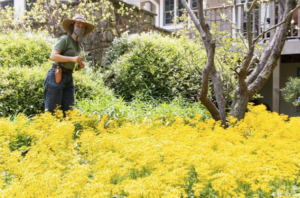
Clara in a swath of Packera aurea, late spring, Fox Chase, PA. . Photo by Nick Yates. I had scheduled for Nick to come out this day and photograph, thinking we’d get peak spring blooms, but it was a damp day with a high in the 70s, and many of the spring bloomers seemed to be on their way out.
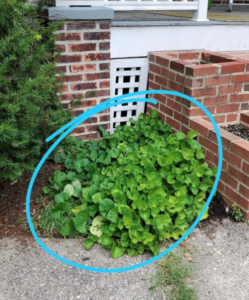
Viola takeover! Late summer, Wilmington, DE. Photo and drawing by Mirna Canales.
Like most gardeners, I usually leave Viola sororia when I see it, but this year they were everywhere! Early in the season, Clara and I were delighted when one of our clients asked us to transplant some of the new crop into dirt patches in her lawn. But one day in late August, while Mirna was weeding, she concerningly called me over to review an area where they had completely occupied the open bed space as ground cover. Considering our client’s opinions and other native plant competition we would sometimes leave them as robust ground cover, and other times remove about half of them.
Perennial Health with Another Humid Summer
The lack of airflow, abundant moisture and lush herbaceous growth this year contributed to many unsightly diseases and conditions. For example, many Coreopsis verticillata exhibited large portions of brown stems likely due to Rhizoctonia web blight and Rudbeckia fulgida seemed to attract something similar, a number of Fothergilla seemed to suffer from wilt or root rot, and many Ilex glabra had leaves that went golden and dropped after the first few cooler and sometimes wetter days after a long hot and humid summer. Most of these plants recovered with some light thinning or pruning of diseased/dead portions and this type of maintenance will be more actively performed in the future as these wet hot wet summers continue.
- Asters, not looking so hot. These ended up getting a full rejuvenating pruning all the way to the ground. Photo by Kelsey Skaroff. Late summer, Aston PA.
- An exploding garden with some unsightly coreopsis. We thinned the coreopsis out by about half, but next year we’ll likely do some early summer cutbacks. Photo by Kelsey Skaroff. Late summer, Wayne, PA.

Mushrooms at a property in Swarthmore, PA. Late summer. Both photos by Kelsey Skaroff.
An entertaining thing we encountered often in the garden this year, indicative of decomposition and wetness, were mushrooms. There was one site in particular that had a dying cherry tree that was removed, and we saw new giant flushes of mushrooms nearly every weekly visit.
Aster Yellows
A less manageable disease I saw more of this year was aster yellows – again, likely due to the excessive moisture and the mild winter, as the pathogen has more success spreading in such conditions. I am used to seeing symptoms on Echinacea and Rudbeckia, but I felt a deep punch in the gut seeing it on Amsonia hubrichtii (bluestar), Eurybia divaricata (wood aster), Conoclinium coelestinum (hardy ageratum), and Packera aurea (golden groundsel).
- Symptoms of aster yellows on hardy ageratum. Late summer, Media, PA. Photos by Kelsey Skaroff.
- Assumed to be symptoms of aster yellows on Packera aurea: L shows herbaceous growth, R shows compacted roots. Found several of these within an otherwise robust, normal looking swath. Late spring, Media, PA. Photos by Kelsey Skaroff.
The recommended best management practice is pulling out infected plants entirely, but two instances made me less inclined to always resort to this: seeing a goldfinch swoop down and eat from an unaffected seed head of infected echinacea, and then a cluster of ants inside an infected flower head. It’s obvious I’d be taking a food source away from the birds – even if it is just one plant – but I wondered if I would be removing a food source for the ants as well? What if they happened to be feasting on Macrosteles quadrilineatus, the insect vector that spreads aster yellows?
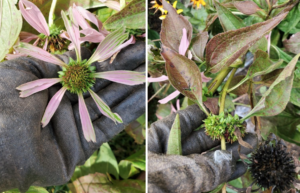
Symptoms of aster yellows on Echinacea. Late summer. Photos by Mirna Canales.
When my crew and I garden, I encourage the use of a delicate hand more often than not, so that we do not interfere too much with the robust local ecology. After some practice and thinking, we decided to remove plants that were 50% or more symptomatic, removing their viable seed heads (which apparently do not spread aster yellows), and leaving the seed heads in the beds. Plants that were less than 50% symptomatic were left in the garden but were pruned of any deformities. In very lush gardens, we would feel more comfortable pulling entire plants out.
Delayed Flowering
I wouldn’t be surprised if the mild winter caused many blooms to arrive later than expected. Crapemyrtles, for example, which I would see while driving around or occasionally in the garden, didn’t seem to bloom until the second week of July. Physostegia virginiana (obedience plant) didn’t showcase its obedience until mid-August, at the earliest. It is likely this has also affected the pollinator’s schedules. I don’t think I’m seeing as many red berries on Ilex verticillata (winterberry) this year, or Aesculus parviflora (bottlebrush buckeye), though it could just be because the fruits are backed or sometimes obscured by the heavy and abundant green foliage.
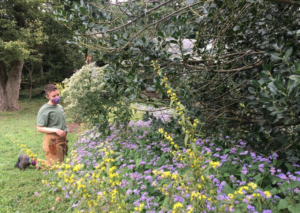
Dena admiring an abundant garden. Late summer, Media, PA. Photo by Kelsey Skaroff.
Invasive Plant Management: Goutweed, Chameleon Plant, and Pinellia ternata
Our long and quiet spring gave us, at some properties, a good amount of time to tackle the invasive perennials Aegopodium podagraria (goutweed) and Houttuynia cordata (chameleon plant). Pulling the goutweed was enjoyable for Clara and me, snacking on a few pieces here and there (it tastes like a carrot), and then taking some home to cook with. The chameleon plant is also edible, but its smell is quite repulsive to some – I saw someone online say its scent was like “gasoline and fish” – and the gardeners were much less enthused about handling it.
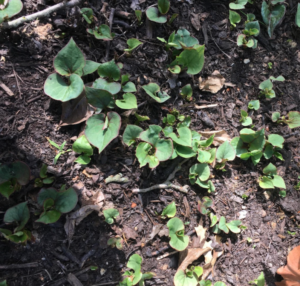
Dreaded Houttuynia cordata! Rose Valley, PA. The photo could have been taken in the spring, fall, or summer since it’s there all the time. Photo by Kelsey Skaroff.
Our method of removal for both plants was to dig up a good chunk of the roots of a single plant in one motion, with a hori hori knife or sickle, intending to weaken the plant over time. This is far less time consuming (and, let’s be honest, defeating) than removing as many of the roots as we can, and is arguably as effective (if you stay on top of it for several seasons). It’s important to note that we are often working in gardens with a native plant palette, so between reseeding and strong root structures, desirable competition is able to run high with the right maintenance. Goutweed and chameleon plants aren’t quite at dormancy yet, and it seems we’ve certainly made a dent in the areas we worked, so I’m curious to see how they re-emerge next year.
We started managing Pinellia ternata around late June, another invasive that grows similarly to goutweed and chameleon plant. This plant felt a bit more like a nuisance, as it was widespread throughout a property – in the lawn and all the beds – whereas the goutweed and chameleon plant were localized to specific areas in the garden. It is also a bit more delicate and smaller, so it leaves more plant material behind, and it seems to pop back up quickly after you have just pulled it out. Next year we’ll tackle Pinellia ternata earlier dedicating more time to solely managing it and not doing anything else.
Spotted Lanternfly
In the summers of 2018 and 2019, I recall seeing spotted lanternflies (SLF) en masse on different plants and surfaces. Memories that particularly stand out are seeing hundreds of adults spotted lanternflies on a small maple tree outside of a Wawa in West Chester, and on Tree of Heaven saplings on the woodland edge of a large property in Chestnut Hill. We were encouraged to smash them whenever we saw them, leave debris on-site, and report the locations back to Penn State Extension so they could update the quarantine map. It didn’t take long for every county we work in to officially be part of the quarantine area.
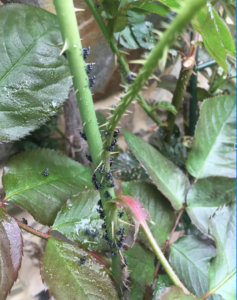
Spotted lanternfly nymphs clustered on a rose. Spring. West Chester, PA. Photo by Kelsey Skaroff.
This year my crew and I continued to control SLF manually, spread awareness, and be patient. Part of cultivating that patience is having fun: laughing while we swat a tree together, scraping off egg sacs from above with credit cards, sometimes being subjected to having the gray chalky substance fall on our face. In one case, I did use Merritt on a mature Tree of Heaven in a client’s backyard. I don’t like using chemicals, but I deemed its use as acceptable, since Tree of Heaven is the host plant of SLF, and this tree was able to operate as a “trap tree.”
Unfortunately, we saw a lot of black sooty mold. One of our clients has locust growing just beyond their property line that is feasted on by spotted lanternflies, and it has resulted in all of the shrubs underneath the tree to sport an unattractive and unhealthy black coating. We managed this by pruning out the worst of it, and next year we’ll likely treat the locust with Merritt.
I perceived the spread of SLF, in general, to be a little different this year than in previous years. With the exception of a rose plant covered with nymphs in the springtime, I saw fewer mass gatherings and more sprawling (an adult or five in one area and then more several feet away), which is better than hundreds on a single tree. I imagined it was because they were able to recognize mine and my gardener’s gaits from afar and hop away before I could smash them.
There were, of course, less fanatical reasons why this year with SLF was different: the average person seemed to know that they were bad and killed spotted lanternflies when they saw them. Even my close friend who works in childcare said her students talked about spotted lanternflies and would participate in the control. Driving around in the suburbs, many trees were wrapped in sticky tape that would trap and kill them (as well as other insects that are important, so this must be considered when one uses tree tape. I, personally, would not use it).
In the field, we’d also sometimes see SLF caught in spider’s webs, or being feasted upon by a praying mantis. And to the industry’s delight, it was discovered this summer that the esteemed Asclepias sp. seems to aid in some control with their toxic sap. With a little bit of time, discovery, and work of the key players in our local ecology (all of them – even us!), nature is starting to control the SLF invasion, and this is exactly what we want it to do.
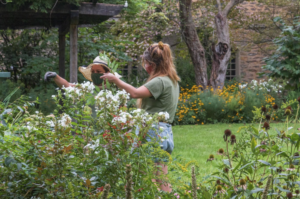
Mirna and I in a late summer garden in Chestnut Hill. Photo by Nick Yates.
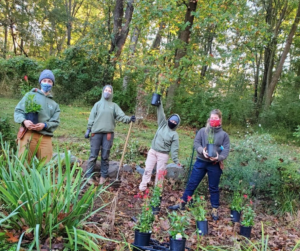
Dena, Clara, Mirna, and I turned a frog pond into a rain garden. Chadds Ford, PA. Photo credit to self-timer.
About the Author
Kelsey Skaroff is an ecological gardener and fine artist based in the greater Philadelphia area with six years in the greens industry. She has a strong background in fine gardening, horticulture, container gardening, and floral design. She is currently Head Gardener at GreenWeaver Landscapes, a full-service landscaping company specializing in sustainability. Regardless of style, she consistently strives to use horticultural practices that are ecologically responsible and that honor biodiversity. Kelsey holds a BFA from The Tyler School of Art; her formal education is apparent in her passion for creativity, design, and critical problem-solving.

